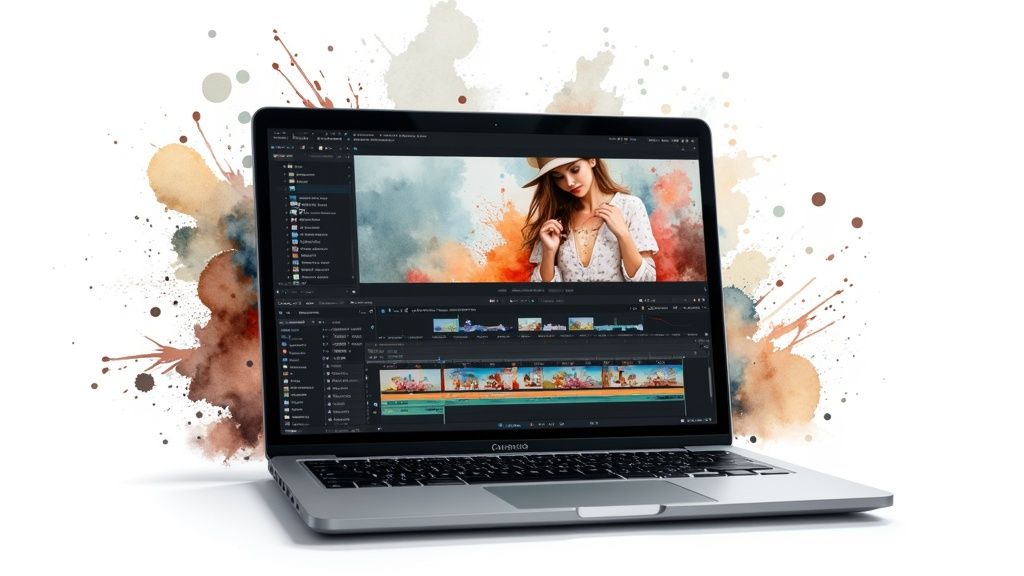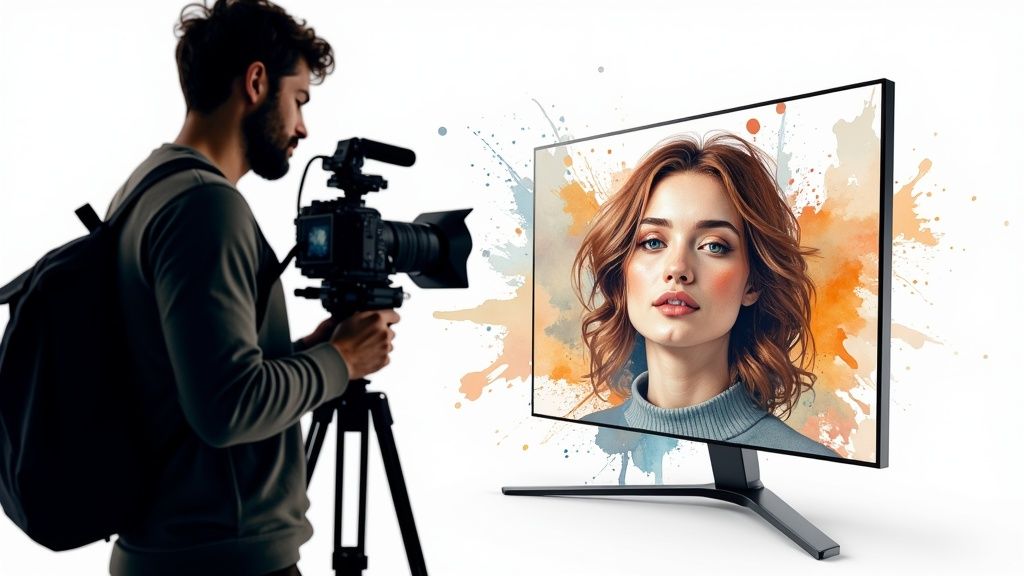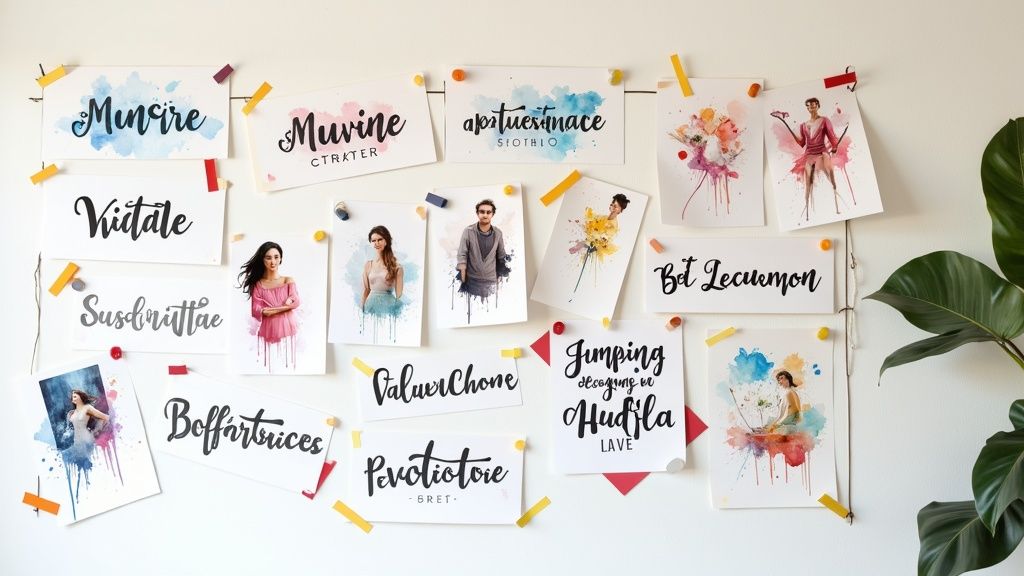Why Text Overlays Are Essential in Modern Video Content

Adding text to videos has become a vital part of creating effective content, especially as viewer habits continue to shift. With more people watching videos while commuting, in public spaces, or during quick breaks, sound isn't always an option. Text overlays help grab attention and convey key messages even when viewers can't turn up the volume.
Think about your own social media habits - you're scrolling through Facebook on a crowded bus and see an interesting video. Without sound, you'd likely skip past it. But with clear text overlays, you can quickly understand the content and decide if you want to watch more. This common scenario shows why "silent viewing" has become such an important consideration for video creators.
Text overlays also make videos more accessible to viewers who are deaf or hard of hearing. Including captions and subtitles ensures that everyone can fully engage with your content, regardless of their hearing ability. By making your videos more inclusive, you naturally expand your reach to connect with a broader audience.
Studies show that up to 85% of Facebook videos are watched without sound, making text overlays essential for effective communication. These overlays help emphasize important points and drive action - whether that's through highlighting key messages or adding clear calls-to-action like "Shop Now" or "Learn More." For real-world examples of effective text overlay usage, check out Three Great Examples of Text Overlay in Video.
The Benefits of Using Text Overlays
- Increased Engagement: Keep viewers watching longer by making content easy to follow
- Improved Comprehension: Help viewers understand your message, even on mute
- Enhanced Accessibility: Make videos accessible to all viewers
- Stronger Calls to Action: Guide viewers toward next steps with clear prompts
- Better Brand Recall: Reinforce key messages for lasting impact
By strategically using text overlays in your videos, you can significantly improve how well your content performs and connects with viewers. This foundational understanding sets the stage for exploring specific ways to measure and optimize video performance, which we'll cover in the next section.
Measuring the Real Impact of Text Overlays on Video Performance
Looking at basic view counts only tells part of the story when evaluating video performance. To get a true understanding of how text overlays affect your videos, we need to examine deeper engagement metrics. These show exactly how viewers interact with and respond to different text elements in your content.
Key Metrics to Track
The most important metrics to monitor include:
-
Retention Rate: Shows how long people keep watching your video. Adding well-timed text overlays, like subtitles or key callouts, can significantly boost retention by keeping viewers engaged. For example, a video highlighting important quotes or stats may hold attention better.
-
Engagement Rate: Measures active participation through likes, shares, and comments. Text overlays that ask questions or prompt specific actions can drive more engagement. A simple "Share your thoughts below!" overlay near the end can spark discussion.
-
Click-Through Rate (CTR): Tracks how often viewers click on links or calls-to-action. Clear text directives like "Click here to learn more" placed at key moments can lift CTR substantially.
-
Play Rate: Indicates the percentage of viewers who start your video. Eye-catching text in thumbnails and opening frames helps convince people to press play.
Analyzing Viewer Behavior Patterns
Running A/B tests with different text overlay approaches reveals what actually works for your audience. Compare videos with varying text styles and placements - for instance, testing subtitles against animated text callouts. Want to learn more? Check out Unlocking the Secrets of Video Engagement: Insights From 1,500 Videos.
Different types of overlays serve different purposes. Subtitles make content accessible and work for silent viewing, while strong calls-to-action drive specific viewer actions. Using a mix of styles helps meet varied viewer needs and goals.
Research shows text overlays make a real difference - studies find they can boost engagement by up to 25% and improve message retention by up to 30%. This matters especially for educational and business videos that need to clearly convey complex information. Learn more at Think Branded Media.
Practical Frameworks for Optimization
Use this simple framework to test and improve your text overlay strategy:
- Hypothesis: Make a specific prediction about how a text overlay will affect your chosen metric
- Testing: Add the overlay and track results
- Analysis: Compare actual performance to your prediction
- Refinement: Use insights to adjust and test again
Taking a data-driven approach to measuring and optimizing text overlays ensures your videos deliver maximum impact. This systematic process helps you continually improve viewer engagement. Next, we'll explore how design choices and overlay placement affect video performance.
Mastering Text Overlay Design and Placement

Adding text to video requires careful planning and design skills to engage viewers effectively. When done well, text overlays help reinforce key messages and guide viewers through your content. Let's explore the key elements that make text overlays work.
The Psychology of Font Choices
Your font selection sets the tone for your entire video. Clean, easy-to-read options like Arial or Helvetica work especially well for mobile viewing and general accessibility. For a more sophisticated feel, classic serif fonts like Times New Roman can add polish - just be sure the style matches your brand voice and content type. The goal is picking fonts that both look good and convey your message clearly.
Color Theory and Contrast
The right color choices make your text pop while setting the right mood. High contrast between text and background is essential - white text on dark backgrounds or vice versa tends to work best. Colors also affect viewers emotionally: reds and oranges feel energetic, while blues and greens come across as calming and trustworthy. Want to learn more? Check out this guide on How to master video editing for Social Media.
Strategic Placement for Maximum Impact
Where you position text can make or break your video's effectiveness. Most pros recommend the lower third of the screen since viewers naturally look there and it avoids potential cutoff issues on different devices. The key is finding spots that highlight your message without blocking important visuals. For more placement tips, see these Text Overlay Best Practices.
Common Mistakes to Avoid
- Overcrowding: Keep text concise - less is more when it comes to on-screen text
- Poor Contrast: Make sure text stands out clearly against the background
- Obstructing Key Visuals: Don't cover up important action or visual elements
- Inconsistent Styling: Stick to the same fonts, colors and placement patterns throughout
Remember, effective text overlays enhance your video rather than distract from it. Pay attention to these design basics and you'll create text elements that grab attention while keeping viewers focused on your content.
Selecting and Mastering Professional Text Overlay Tools
Once you've got a solid grasp of design principles, you'll need the right software to create your text overlays. There are many options available, each suited for different skill levels and needs. Your choice will depend on your budget, technical comfort level, and the types of overlays you want to create.
Essential Features in Text Overlay Software
When evaluating text overlay tools, look for these key capabilities:
- Rich Font Selection: Your tool should provide both basic and distinctive fonts to match your brand identity and video style. The more font options, the better your creative flexibility.
- Design Controls: Look for complete control over text appearance - from basic size and color adjustments to adding drop shadows, borders, and background elements for better visibility.
- Movement Options: Simple transitions like fades help catch viewer attention. More advanced tools offer text animation and the ability to track moving objects.
- Easy-to-Use Interface: The software should be straightforward to navigate with drag-and-drop features and clear editing tools that make text creation quick and simple.
- Multiple Export Formats: Being able to save your video in different formats and resolutions ensures it displays properly everywhere you share it.
Comparing Popular Text Overlay Tools
Here's a quick look at some leading options:
| Tool | Cost | Ease of Use | Advanced Features | Best For |
|---|---|---|---|---|
| Clipchamp | Free/Paid | Beginner | Basic Animations | Quick edits, social media |
| Adobe Premiere Pro | Paid | Professional | Extensive | Complex projects, high-quality videos |
| DaVinci Resolve | Free/Paid | Intermediate | Robust | Color grading, advanced editing |
| Final Cut Pro | Paid | Professional | Apple Ecosystem | Mac users, professional editing |
| Aeon | Contact Us | Easy | AI-Powered | Publishers, automated video creation |
While these aren't all the options out there, they're good starting points. For example, Clipchamp works well for quick social posts, while Adobe Premiere Pro gives you everything needed for major video projects.
Optimizing Your Workflow with Text Overlays
Think about how text overlays fit into your overall video production process. Many video creators use multiple tools together effectively. They might start with basic edits in Clipchamp, then polish everything in DaVinci Resolve with proper color correction. Adding text at the right stage of this process helps maintain quality without slowing things down. Tools like Aeon can speed up parts of the workflow, especially for publishers who need to produce videos quickly. This practical approach helps you create great videos while keeping the process manageable.
Advanced Techniques for Creating Dynamic Text Overlays

Text overlays can do much more than just display static information. By incorporating movement, animation and smart design techniques, you can create overlays that actively draw viewers in and make your content more compelling. Let's explore some proven methods for crafting text that enhances your video's visual appeal and impact.
Kinetic Typography: Bringing Text to Life
Kinetic typography adds motion and energy to your text elements. This could be as straightforward as a gentle fade-in or as elaborate as text that flows across the screen in a choreographed sequence. For instance, you might have key phrases that subtly pulse to emphasize important points, or words that gracefully enter from different directions. These dynamic touches do more than catch the eye - they reinforce your message and keep viewers engaged.
Motion Tracking: Text That Follows the Action
Take your text overlays to the next level with motion tracking. This technique lets you attach text to specific objects or areas in your video frame, so the words move naturally with the content. It's especially useful for tutorials where you need to label specific tools or features, and for product demos that highlight key attributes. By integrating text seamlessly with on-screen movement, motion tracking helps viewers stay focused while better understanding the content.
Advanced Animation Principles for Text Overlays
While simple animations are effective, mastering core principles like easing, timing, and anticipation adds polish and professionalism. Easing creates smooth transitions instead of abrupt starts and stops. Good timing ensures animations match your video's natural rhythm. Anticipation helps set up movements so viewers can easily follow along. These small but important details make text overlays feel like natural parts of your video rather than afterthoughts.
Implementing Dynamic Text Overlays in Your Workflow
Adding these techniques to your videos doesn't need to be complicated. Popular editing software like Adobe Premiere Pro and DaVinci Resolve includes robust text animation and motion tracking tools. For a more automated approach, platforms like Aeon help streamline the process. You can create professional dynamic text overlays without extensive manual work. Aeon's AI features speed up production and help manage high-volume video content efficiently. By picking the right combination of tools and methods, you can develop text overlays that strengthen your message and keep viewers watching.
Platform-Specific Optimization Strategies for Text Overlays

Creating effective text overlays requires thoughtful design choices based on how each social platform displays video content. Every platform has its own unique technical specs, audience behaviors, and best practices. Let's explore how to optimize your text overlays for maximum impact across different social channels.
Understanding Platform-Specific Requirements
Different social platforms serve different purposes and attract different types of viewers. For example, Instagram thrives on eye-catching visuals with quick, impactful messaging in vertical format. YouTube gives you more flexibility with timing and placement but needs clear, easy-to-read text that works for a broad audience. LinkedIn's professional focus means text needs to be polished and information-rich. Read also: How to create video content for social media - a proven success framework.
Optimizing Text Overlays for Instagram
Keep your Instagram text short and punchy with modern, readable fonts. Motion and animated text can help catch attention as users quickly scroll their feeds. Since many watch Instagram Stories without sound, make your captions large and clear enough to read on mobile screens. Most Instagram users browse on phones, so mobile-first design is key.
Tailoring Text for YouTube
YouTube viewers often watch longer content, so your text overlays should complement the audio while staying clear and readable. Good subtitles and captions help accessibility and understanding, especially for non-native speakers or those watching in noisy places. Consider adding clickable elements within text overlays to boost engagement.
Maximizing Impact on LinkedIn
LinkedIn users expect professional, polished content. Clean text overlays featuring data points and key takeaways work well here. Use bullet points and simple data visualizations when highlighting important info. Choose professional fonts and keep language formal yet approachable.
Managing Aspect Ratios and Text Formatting
The aspect ratio (width vs. height) matters for each platform. Square videos work on Instagram, while YouTube favors horizontal format. Your text overlays need to look good and stay readable across these different dimensions. Keep fonts consistent for branding but adjust text placement and length to match each platform's style.
Platform-Specific Best Practices
| Platform | Best Practices |
|---|---|
| Short, impactful text; Animated overlays; Vertical video optimized text placement; Consistent use of hashtags within the overlay | |
| YouTube | Clear subtitles; Clickable annotations; Concise explanations complementing the audio; Eye-catching title cards |
| Professional font choices; Data visualization within the overlay; Concise, informative bullet points |
When you understand what works best on each platform, you can create text overlays that truly connect with viewers. Tools like Aeon make it easier to adapt your text and video formats across different social channels. To learn more about optimizing your video content strategy with Aeon, visit Project Aeon.